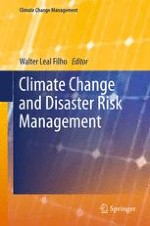2013 | OriginalPaper | Chapter
10. Environmental Performance and Vulnerability to Climate Change: A Case Study of India, Nepal, Bangladesh and Pakistan
Author : Medani P. Bhandari
Published in: Climate Change and Disaster Risk Management
Publisher: Springer Berlin Heidelberg
Activate our intelligent search to find suitable subject content or patents.
Select sections of text to find matching patents with Artificial Intelligence. powered by
Select sections of text to find additional relevant content using AI-assisted search. powered by
